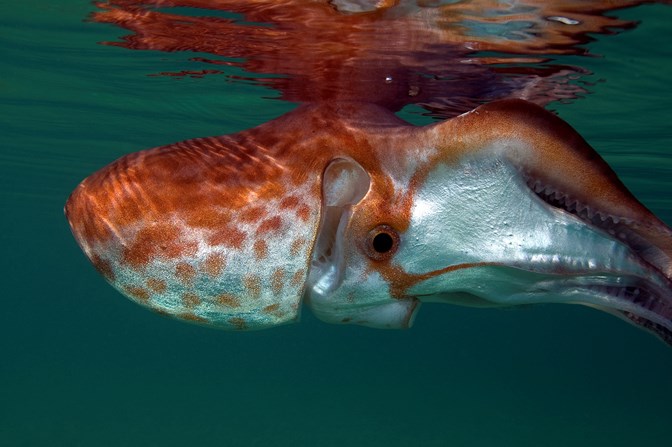Experts reveal the quirky lives and breeding techniques of creatures washed up on Victorian beaches
Scientists are unsure why several octopus species, rarely seen by humans, have been found washed up on beaches along Victoria's surf coast.
Parks Victoria has received reports of two Blanket Octopuses (Tremoctopus) found at Barwon Heads and Port Fairy, and several Knobbed Argonaut shells (Argonauta nodosus, also known as paper nautilus) washed up at Lorne main beach, Point Addis, Kennett River and Torquay.
'Paper nautilus shells' are prized by beachcombers but not many know their life story, or that they’re related to the world’s most sexually size-dimorphic large animal – the Blanket Octopus.
While the species themselves aren't rare, they are rarely encountered by people. Both blanket octopuses and Argonauts spend their entire lives in the surface waters of open ocean.
Similarities between the two species include:
- Females are much larger than the males
- Both species have an unusual mating style. The tiny male detaches an arm containing sperm, passes it to the female, then dies, meanwhile his sperm arm crawls into her gills where it sits until she is ready for fertilisation.
Sometimes storms or onshore winds push female argonauts into coastal waters, which is too shallow to allow them to dive. They can then get caught in wave action and wash up on the beach.
It is suspected that conditions which have recently resulted in the Argonauts washing up have also caused the female Blanket Octopuses to be washed ashore.
Facts about the Blanket Octopus:
- The male is the size of a jellybean, whereas females have been known to grown to a metre in length.
- When fleeing from predators, they can cast off tentacles to defend themselves or cause confusion.
- They have been known to carry tentacles stolen from the Bluebottle/Portugese Man-Of-War jellyfish, probably also for defence.
Facts about Argonauts:
- The female builds herself a beautiful shell; a protective casing in which to lay her eggs.
- She also uses her shell to trap air gathered from the water surface, to achieve neutral buoyancy.
- Female argonauts are estimated to produce over a million eggs during their lives.
Quotes attributable to Dr Julian Finn, Senior Curator, Marine Invertebrates, Museums Victoria:
"Argonauts and blanket octopuses are two of the most fascinating creatures to live in our oceans. While we can study the individuals that unfortunately wash up on our beaches, much of their lives remain a mystery."
"Beachcombers, hoping to secure a perfect argonaut shell for their collection, will need to be quick. Female argonauts use their delicate white shells to house their eggs, in order to protect them until they hatch. Sea birds love to eat argonaut eggs. They are quick to spot a stranded argonaut, pierce the top of the shell with their strong beaks, and devour the eggs housed within."
"Like argonauts, female blanket octopuses grow to a much larger size than the dwarf males. Female blanket octopuses do not lay their eggs in a shell. The female attaches all of her eggs to a rod that she holds within the protection of her arms."
"The Blanket Octopus gets its name from the expanded webs (or 'blankets') that unite the female's dorsal arms. When swimming, she can unfurl and trail these giant webs, giving her an apparent total length of up to 2 metres. These webs are divided into sequential components, which can be spontaneously cast off as long free strips, potentially acting to distract approaching predators."
"We're not sure why but both male and small female Blanket Octopuses usually carry fragments of venomous tentacles of Blue-bottle between their arms. This could be to either help them catch food or protect themselves from predators."
Quotes attributable Dr Mark Norman, Chief Conservation Scientist Parks Victoria:
"Argonauts are one of the strangest and most beautiful creatures of open ocean. They are free-swimming octopuses. The female builds an intricate delicate shell which is one of the most beautiful of all beach-washed shells, while the tiny pygmy males are shell-less. The two sexes live separate lives in open ocean but sometimes come together in large groups."
"Past strandings of argonauts in Victoria have involved tens of thousands of females washing ashore with their shells."

